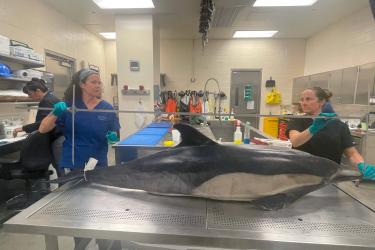To calculate the cumulative climate effects that influence Chinook salmon extinction risk, we use population dynamic models. These statistical models are known as life‑cycle models because they integrate multiple climate-related impacts that affect salmon throughout all stages of life.
Life cycle model simulations rely on detailed studies of individual life stages and projections of future climate. They help quantify the potential impacts of climate change and of specific proposed mitigation actions such as dam operations or habitat restoration changes.
Information from life‑cycle models also supports decisions on risk imposed by federal actions, informing environmental impact statements required under the National Environmental Policy Act and biological opinions required under the Endangered Species Act.
Our life‑cycle models project that Snake River spring/summer Chinook salmon populations will decline dramatically in the coming decades. They show that this decline is due primarily to rising sea surface temperatures and changes in freshwater temperature and flow. Consistent with these projections, we have already seen record-low returns of salmon species across the West Coast in response to the marine heat wave of 2014-2016.
When climate is assumed to be stable, with historical levels of variability, individual simulations showed variability in spawner numbers but, on average, stayed constant over time (blue line and polygon). However, when we imposed forcing from climate change, either under the RCP 4.5 (light orange) or RCP 8.5 (dark orange) emissions scenarios, all populations rapidly declined below the quasi‑extinction threshold.
Projections from model output show the most dire climate effects on salmon occurring in the marine life stage. Therefore, we presently focus on the interspecific dynamics that affect marine survival
We are building a set of end‑to‑end conceptual, statistical, and ecosystem models of intermediate complexity to fully capture our understanding of relationships between species. These models will explore how climate alters the marine environment and will help us to identify management tools to mitigate these effects on salmon.
References
Crozier, L. G., B. J. Burke, B. E. Chasco, D. L. Widener, and R. W. Zabel. 2021. Climate change threatens Chinook salmon throughout their life cycle. Communications Biology 4:222. https://doi.org/10.1038/s42003-021-01734-w
Crozier, L. G., and R. W. Zabel. 2020. Middle Fork and South Fork Salmon River MPGs of the Snake River Spring/Summer-Run Chinook Salmon ESU in R. W. Zabel, and C. E. Jordan, editors. Life Cycle Models of Interior Columbia River Basin Spring/Summer-Run Chinook Salmon Populations, U.S. Department of Commerce, NOAA Technical Memorandum NMFS-NWFSC-156. https://doi.org/10.25923/phfm-wq72.



